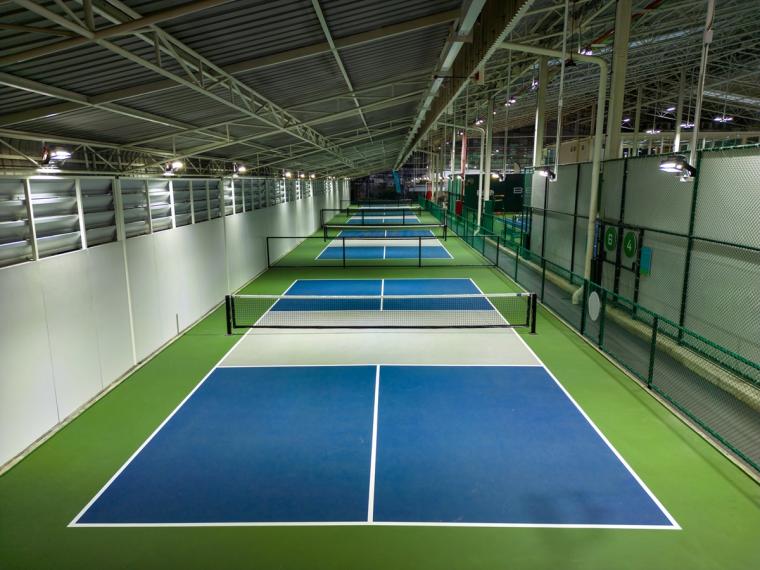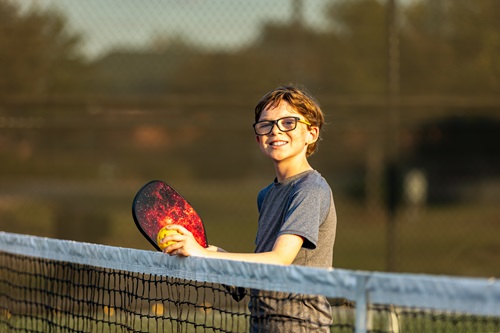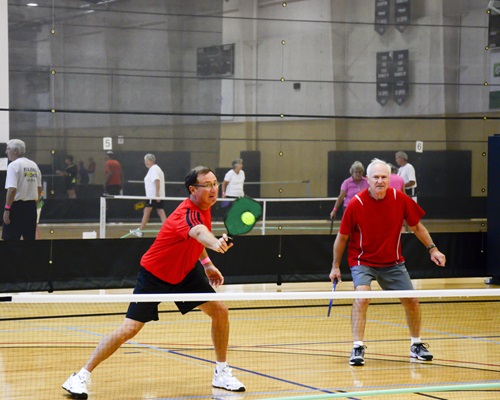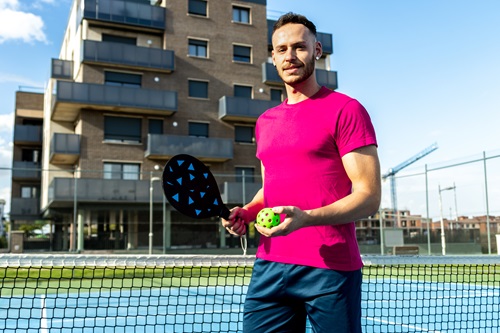
Depending on how you look at it, pickleball either has too many players (is there such a thing?) or too few courts (that is a thing) and the shortfall is definitely causing problems.
We’ve already seen the conflicts between pickleball and tennis players jockeying for court time, with players of both sports. Even the sport’s governing body is aware of it.
“We have a shortage of courts,” says Mike Nealy, USA Pickleball’s Chief Operating Officer. “There aren’t enough places to play.”
Park and rec organizations, as well as community associations, are building facilities, he notes. But there is real interest among private clubs – and it’s directly tied to sports tourism.
“Clubs are really ramping up their court construction,” Nealy notes. “They’re asking questions about how many courts will be needed to draw in a tournament.”
As a result, he notes, competitive facilities are on the uptick, some with more than 40 courts.
 Several years ago, Carl Schmits, USA Pickleball’s Managing Director of Equipment Standards & Facilities Development, gave a presentation at a meeting of the American Sports Builders Association. The presentation was entitled “Why 2024 won’t be like 1984 - Enabling the Boom, Eliminating the Bust” and dealt with the fact that that several decades back, racquetball was a driving force. Clubs could hardly build courts fast enough to keep up with the demand. These days, racquetball has diminished in player numbers and clubs are repurposing those spaces. And, in fact, remembering those days, many clubs were slow to adopt pickleball as the next big thing.
Several years ago, Carl Schmits, USA Pickleball’s Managing Director of Equipment Standards & Facilities Development, gave a presentation at a meeting of the American Sports Builders Association. The presentation was entitled “Why 2024 won’t be like 1984 - Enabling the Boom, Eliminating the Bust” and dealt with the fact that that several decades back, racquetball was a driving force. Clubs could hardly build courts fast enough to keep up with the demand. These days, racquetball has diminished in player numbers and clubs are repurposing those spaces. And, in fact, remembering those days, many clubs were slow to adopt pickleball as the next big thing.
But rather than being, like racquetball, a club- or college-based sport that requires specific facilities (most of which are private and cannot be accessed without a membership, or at least without a fee), pickleball can be played outdoors in a municipal setting, with its equipment inexpensive and readily available.
Its players are sociable and welcoming to newcomers, something else that works to increase engagement, adds Nealy. The college club market is growing, and gym classes are incorporating the sport, introducing players at an even younger age. In fact, the fastest growing age group is 20-30-year-olds. AAU hosts competitions for the sport as well.
“It speaks to pickleball’s appeal to all age groups,” Nealy adds.
And while pickleball is not yet in the Olympics, it appears to be only a matter of time, since the sport has all the ingredients the IOC likes: an embrace by a younger demographic, an enthusiastic fan base and strong participation among both genders. It is being incorporated into community masterplans
One of the mechanisms USA Pickleball uses to track the growth of the sport is its comprehensive data base of venues and locations, found on its website. Places2Play provides the public with the ability to locate courts both public and private in all 50 states. (Venues can be as complex as multi-court facilities that host tournaments, or they may be lines applied to the floor of a recreation center, allowing pickleball play in addition to other activities being offered).
And make no mistake about it; new facilities are coming online all the time and joining those that already host competitions. In Gulf Shores, Alabama, there are 12 new outdoor lighted courts at the Gulf Shores Sportsplex. The Meadowbrook Athletic Complex in Ellicott City, Maryland has 16 permanently lined indoor courts. And Naples, Florida is the longtime home of the Minto US OPEN Pickleball Championships, held in Naples Community Park, nicknamed the “Pickleball Capital of the World.”
Obviously, pickleball’s current court shortage does not appear to be a stumbling block to its growth. Vacant big-box stores are being converted into what have become known as “picklemalls” and many of those facilities have two stories – something that appeals to entrepreneurs looking for the next big thing.
 MarketWatch has been keeping an eye on the trend, calling it the savior of America’s malls. The article profiled a New Jersey entrepreneur named Andrew Pessano who, together with his partners, wanted to open a pickleball club but became discouraged about the high start-up and construction costs.
MarketWatch has been keeping an eye on the trend, calling it the savior of America’s malls. The article profiled a New Jersey entrepreneur named Andrew Pessano who, together with his partners, wanted to open a pickleball club but became discouraged about the high start-up and construction costs.
They had their a-ha moment when they realized that everything they wanted (a big space with high ceilings, lighting, HVAC, restrooms, accessibility, parking and more) already existed, in the form of a vacant Burlington store. They transformed it into Proshot Pickleball, a membership facility that offered players a choice of eight cushioned courts, viewing decks, a pro shop and a players lounge.
And it worked. Pessano said that since opening in mid-February, he has already signed up more than 300 paid members.
“The first couple of months we’re busy, busy,” he adds.
The conversion of stores into pickleball playing facilities has become one of the biggest trends on the market. Malls (and strip malls, for that matter) love it because it removes the blight of vacant properties – with the bonus of bringing business to neighboring stores when players have finished their games.
According to a press release from The Sports Facilities Companies, nearly half of SFC’s facilities accommodate pickleball, led by the newly opened Rhythm and Rally Sports and Events in Macon, Georgia, touted as the world’s largest indoor pickleball facility after converting a vacant mall.
SFC announced it will manage the Lake Kennedy Racquet Center, which is under construction and set to open in July 2024. This facility in Cape Coral, Florida, is designed to become a central hub for both competitive and recreational pickleball players featuring 32 permanent pickleball courts next to 12 tennis courts.
 SFC reports that over 90 percent of community planners and facility developers consider including pickleball in their feasibility studies for new complexes. For venues without permanent courts, new and existing facilities can easily convert their playing surfaces to accommodate pickleball courts.
SFC reports that over 90 percent of community planners and facility developers consider including pickleball in their feasibility studies for new complexes. For venues without permanent courts, new and existing facilities can easily convert their playing surfaces to accommodate pickleball courts.
“Pickleball is more than a sport; it’s a catalyst for community development and social engagement,” said Jason Clement, CEO of The Sports Facilities Companies. "Through the establishment of facilities like Rhythm and Rally and the upcoming Lake Kennedy Racquet Center, we are not only meeting current demands but are also influencing the future of urban sports facilities."
“It’s clear that The Sports Facilities Companies is at the forefront of the pickleball movement and helping our community meet the demand for courts,” said Southern Pickleball co-founder Paul Midkiff. “Notably in Macon, we’ve had the ability to host events at what is now the world’s largest indoor pickleball facility which has significantly enhanced the player and spectator experience.”
Only time will tell what the breakeven point will be. After all, the sport is still growing and players are getting younger all the time. Pickleball is making money, adding players and growing in competitive events. And should the IOC ultimately decide to add pickleball as a podium sport, the economic impact of the sport could become stratospheric.
“I am talking to the IOC,” says Nealy, “and this is what they want.”

